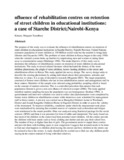| dc.description.abstract | The purpose of this study was to evaluate the influence of rehabilitation centers on retention of street children in educational institutions in Starehe District, Nairobi Province. United Nations estimates population of street children at 150 Million world-wide but the number is rising daily (Shorter and Onyancha 1999). The problem of street children in Kenya began in the early 1950s when the colonial system broke up families by imprisoning men and women or taking them away to concentration camps (Mathenge 1996). The main objective of this study was to determine the influence of rehabilitation centers on retention of street children in educational institutions. The study reviewed related literature which included the history of the street children phenomena, the plight of street children, factors leading children to the streets and rehabilitation efforts in Kenya This study applied the survey design.
The survey design seeks to describe the existing phenomena by asking individuals about their perceptions, attitudes and behavior or values. It is a type of descriptive research (Mugenda 2003). The target population consisted of former street children who are in four rehabilitation centers and management staff in these centers. Members of the sample were selected using probability sampling which is based on the concept of random selection. This is a controlled procedure that ensures that each population element is given a non zero chance of selection (cooper (2006).
The study applied stratified random sampling because the population was not homogenous (Kothari 1990). A questionnaire and interview schedule was used to collect data Questionnaires were completed by former street children in rehabilitation centers while interviews were scheduled for management staff in these centers. A pre-test was carried out at Shangilia Children's home in WestIands District and Joseph Kangethe Childrens Home in Dagoreti District in order to assess the validity of the instrument. To improve reliability, conditions under which the measuremeet took place were standardized by ensuring that external sources of variation such as boredom and fatigue were minimized to the extent possible.
Data was analyzed using Statistical package for the social sciences (SPSS) and then it was presented in form of tables and interpreted. The study found out that most of the children in the centers had been potential street children. All the centers provide the children with basic needs such as food, clothing and shelter and also pay their school fees. The number of boys is higher than that of girls. The government needs to supprt these centers and provide them with building space to ease congestion I suggest that research needs to be done to find out what happens to children after leaving the centers and how children in the streets can be assisted to leave the streets. A study should also be carried out to find out why children prefer staying in the centers instead of living with their relatives. | en_US |

